Grocery shopping skills to teach our kids
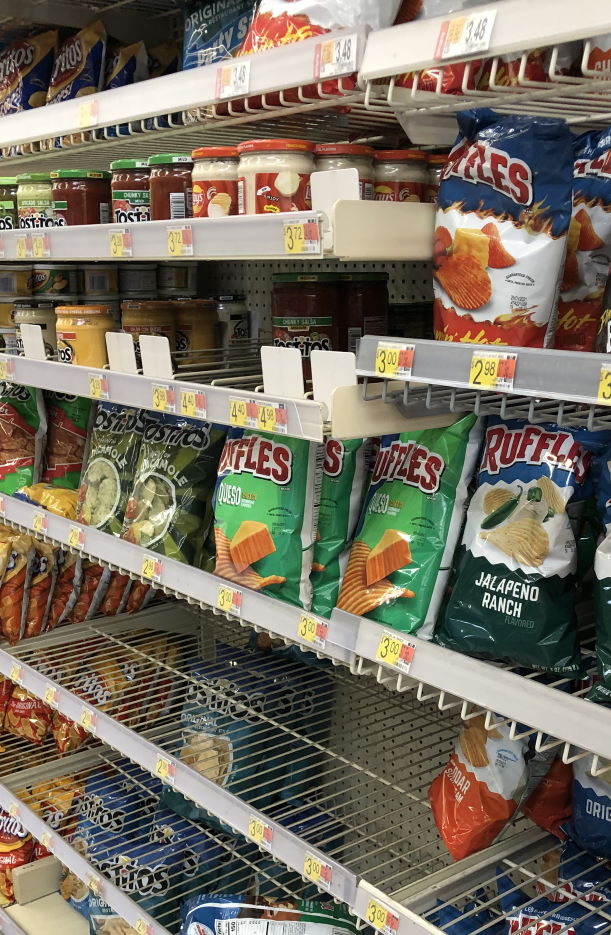
Chips and queso
Shopping with kids can be a dreaded experience. Trying to make sure you have everything on your list and making sure the kids behave can make a grown man cry. Hearing the constant “Can we get this?” throughout the whole shopping experience. No, you cannot have pickled beets. Do you even know what that is? Do you even like that?
I’ve recently started to shop on my own. I wait until the kids are napping with mom and I go and take care of the shopping by myself. But what happens when your kids get older? They need to know how to shop for groceries. But how can we teach our kids grocery shopping skills?
Why should we be teaching kids about grocery shopping?
Teaching our kids grocery shopping skills can help them later in life. It’s one of those skills we really don’t think too much about. How did you learn to be a good grocery shopper? Did your parents teach you? Or did you just learn as you went?
My first several jobs growing up were working in a grocery store. Not only did my mom and dad teach me how to shop but I learned several tricks and tips to how grocery stores operate while working in one. Some of the things stores use to get you to buy more groceries are both interesting and mind-blowing.
Teaching kids about grocery shopping can also teach them valuable skills they will need in school. They can practice elementary-level math skills of addition, subtraction, multiplication, and division.
Here are some grocery shopping skills to teach your kids:
Before you shop
Make a grocery list
One of the first steps to going shopping is making a list. If you don’t have a list how will you know what to buy at the store? I have been shopping when I forgot my list. It was no fun. I was constantly either texting my wife and asking her questions. Or I was forgetting things that we needed.
In our house, we keep a running list as we run out of items or are getting low. Someone will normally say we are out of this or we need this. My first reply is, “Did you put it on the grocery list?”. Because if they don’t I will more than likely forget it.
Don’t forget the non-food items you may need to pick up also that you normally get from the grocery store. Toilet paper, paper towels, trash bags, aluminum foil, batteries, and any other non-food staples that get used often. Picking those up at the grocery store will be a lot cheaper than having to run to your local convenience store.
Budgeting for groceries
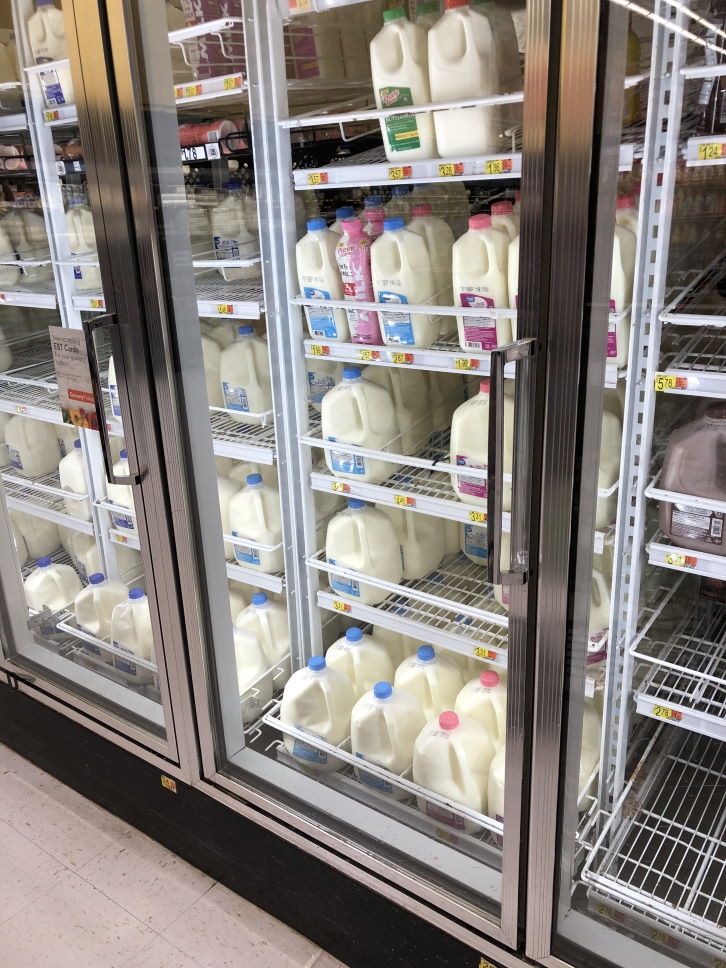
Buying milk
Another reason we make a grocery list is so we don’t overspend. Teaching your kids how to make a grocery budget and then stick to it is a great way to introduce your children to household budgeting.
You can make your grocery list and then estimate how much each item will cost. Then total it up and determine if what you have is within your grocery budget. If it doesn’t match up then you can find cheaper items to substitute.
For example, maybe you had planned to cook steaks and potatoes this week. But after estimating the cost of steaks it took you over your grocery budget. In this case, maybe you swap out steaks with a cheaper option like chicken.
When to grocery shop
There are certain days and times where the grocery store will be more crowded than others. Typically the weekend before a holiday is a busy time to go shopping. If you want to avoid crowds you may decide to do your shopping on a Monday that week.
Also, be mindful of the time of day. A lot of people will run by the store and shop right after they get off work at 5 pm. When this happens all the registers could be backed up and you will waste time waiting in line. Usually, you want to try and go shopping earlier in the morning or late evening to avoid crowds.
Avoiding crowds also helps get you in and out of the store quicker. The grocery store wants you to stay in the store as long as possible because statistically speaking the longer you are in the store the more you will buy.
Don’t shop for groceries while hungry
Shopping while hungry is an easy way to blow your budget. And this also relates to when to go shopping. If you eat supper and then go shopping you are less tempted to grab extra snacky foods that are not on your list.
If you are hungry and go shopping you might see something and buy it just because “that looks yummy”. While it may look yummy you may regret buying that extra food or regret buying something that isn’t good for you or your family.
When shopping with kids it may be handy to at least give them a snack before you head out if you can not go shopping after a meal. Not only will this make everyone happier but also prevent them from asking for everything in the store.
While you shop
How to pick fruit and vegetables

Learn to prick fruits and vegetables
While I was growing up my dad always had a garden. And when I was old enough he allowed me to plant whatever I wanted in a section of the garden. I raised pumpkins, canteloupe, peppers, watermelon. And throughout the whole process, my dad taught me when was the right time to pick fruits and vegetables.
Each and fruit and vegetable has its own rules and guidelines for what should be bought and not be bought. Here are some general tips for things we buy the most of.
Bananas – If you are eating them right away you want yellow bananas. But if you are buying for the week then pick a few green ones with some yellow ones. Avoid bruised (black spots) bananas.
Apples – Check for bad spots or soft spots. Apples should be firm.
Peaches – Avoid peaches with brown spots. And if they are really firm they may not be ripe.
Watermelon – Slap it and see if it sounds hollow. Hollow usually indicates ripeness. Also, check for a yellow spot. If it doesn’t have a yellow spot it may have been picked too early.
Cantaloupe – Should have no visible bruises. Also should smell sweet but not too sweet.
Lettuce – Avoid browning lettuce when buying in a bag. If buying ahead should be firm to the touch.
Tomatoes – Should be red and not too hard. If there is a mushy spot avoid it as it is overripe.
You can also explain to your kids about the amount of produce you should buy. If you don’t normally eat more than 2 bananas in a week you shouldn’t buy a bunch of 5. Let them know that produce is perishable and doesn’t last forever.
How to compare price per unit

How to compare price per unit
Price per unit is how some brands will get you. They will advertise a new bigger size box and you may automatically think that it will save you money. But check the price per ounce on the label if available or get a calculator out and compare.
Also, check different sizing. In particular with eggs. In most cases buying large eggs is cheaper than buying other sizes of eggs. You may think you will save by buying a medium or small egg. But they are typically more expensive per dozen.
Know when to buy generics or store brands
If a product is popular then it will likely have a generic or store brand. But buying the generic is not always the best value. I find there is no hard and fast rule to this. I have bought some store-brand green beans that I absolutely love. But other store brand green beans were just awful. I mean they are green beans, how do you mess that up?
I find most store-brand cheese or bacon is just as good as the name brand. Condiments like ketchup, mustard, ranch are all typically comparable also. But there are things like cream cheese that I just don’t like the generic. They may taste similar but sometimes the texture or consistency is off.
Nutrition labels
Kids need to learn to read and interpret nutrition labels. Not only for how many calories are in the food they are eating but also for nutritional value and ingredients.
I don’t know how many times my kids will ask for something and say it is only 100 calories per serving. Then I ask them to look at how much is a serving. Typically it is a very small size that isn’t conducive to what a normal person would think is a serving.
One day I bought some Keto-friendly snack bars. They were supposed to be a chocolate peanut butter flavor. But they had no chocolate or peanut butter. My son asked to try one and I allowed him to eat one. He spits it out after a few bites and asked what was in it. I show him the nutritional label and the first ingredient was chicory root. What is chicory root? I don’t know but it doesn’t taste good.
Teach your kids how to tell how many sugars and how much fat is in the food they eat. Break down the nutritional labels so they can make better decisions when they become an adult.
Choosing healthy options

Choosing healthy options
By using the nutrition labels and picking out good fruits and vegetables, we can teach our kids how to eat healthy. We can help them pick out a snack of some grapes over a sugary cereal bar.
We can also help them eat more protein and have fewer carbs in their diet. Help them pick out meats that they will enjoy and can help cook.
Teach them to watch out for marketing tricks. As seen in the picture above they call this food “smartfood” but that is just the brand name. Is it really smart to buy popcorn flavored with donuts? Just because the package says it is healthy doesn’t mean it is healthy.
Watching for expiration dates
Kids are not aware that expiration dates are a thing. I have seen my own son eat some candy that was expired well over a year. And while some expiration dates are more of a suggestion there are some they need to be aware of that should be respected.
Raw Meat – Usually the store puts a sell-by date on meat. But even then eating it too much farther than the sell-by date and the quality goes way down.
Milk – You might be ok to go a day or two beyond the date on milk. But really just make sure you don’t buy too much. We don’t have to worry about that in our house as we drink 4 gallons a week.
Lunch Meat – If it hit the date I would probably just throw it out. They have a lot of preservatives in the meat but those don’t always work out so well.
Bread – Bread items are usually good past their sell-by date. But the sell-by date is a good indication of how fresh the bread is. Since bread gets stocked almost daily in most big stores it should be good.
Pull items from the back
If you are like most people when you shop you just grab the first item you see on the shelf. But there is good reason to pull items from the back of the shelf. When grocery stores stock they are supposed to pull all the old products down, put in the fresh products, and then put the old stuff in front of the newer product.
Does this always happen? Nope. But if you want the freshest product then I would suggest always pulling from the back. This is usually true if you buy bagged lettuce or raw meat. Pulling from the back will get you a fresher product that will last longer.
Don’t always shop from the big displays
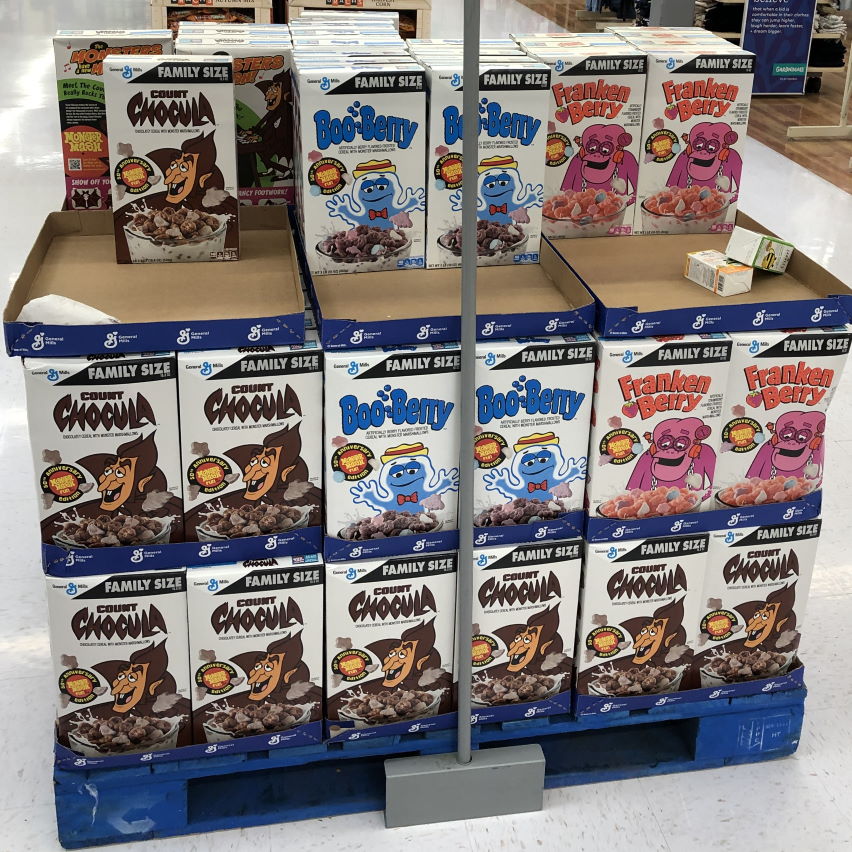
Big cereal display
When grocery shopping at your local grocery store you will notice in the larger aisles or at the end of aisles they always have big displays of the same product. You might look at these displays and automatically think that those items are on sale. But most of the time they are not.
Food companies strike deals with stores to sell them large quantities of items at a reduced cost. And in some cases, the store will pass those savings on to you. But sometimes they don’t. Because those displays may be seasonal items that are bought often by customers they may have no reason to discount the items.
Make sure you and your kids compare the prices of those items to other ones on the normal shelves and teach your kids to carefully assess which product is the better value. Just because they have a lot of a product doesn’t mean it is on sale or cheaper.
Clearance or marked down items
When grocery shopping with your kids teach them not to be afraid of clearance or marked-down items. Clearance items in a grocery store seem like a weird concept but more and more stores are using this technique to clear out items to make room for new products.
And they don’t use it so much but you used to get canned goods really cheap if the can was dented. I think most grocery stores have abandoned this practice because people would dent the cans on purpose.
I would say to caution your kids about buying marked-down raw meat items. Unless they are going to be used within a day or two it’s best to avoid marked-down raw meat. More than likely they are marked-down because the shelf life is really limited.
Understand seasonal food
If you pay attention when you shop you will notice that grocery stores have more of certain foods at different times of the year. For instance, in early summer stores will have lots of marshmallows, chocolate, and graham crackers to promote smores (for camping). Right before the new year, they will have large amounts of black-eyed peas and ham. Around Thanksgiving, you will see tons of turkey, pumpkin pie filling, and cranberries.
Stores know based on previous trends as to what customers will buy. And typically they have these seasonal foods out early and on sale. We can teach our kids to buy those seasonal items during this time and can save on food costs.
Also during the spring and summer is the best time to buy fresh produce and fruits. Buying a watermelon in the middle of summer is the cheapest time to purchase one. And they are more likely to get a good watermelon during summer instead of buying them in the middle of winter.
Leaving the store
Avoid the temptation of checkout candy
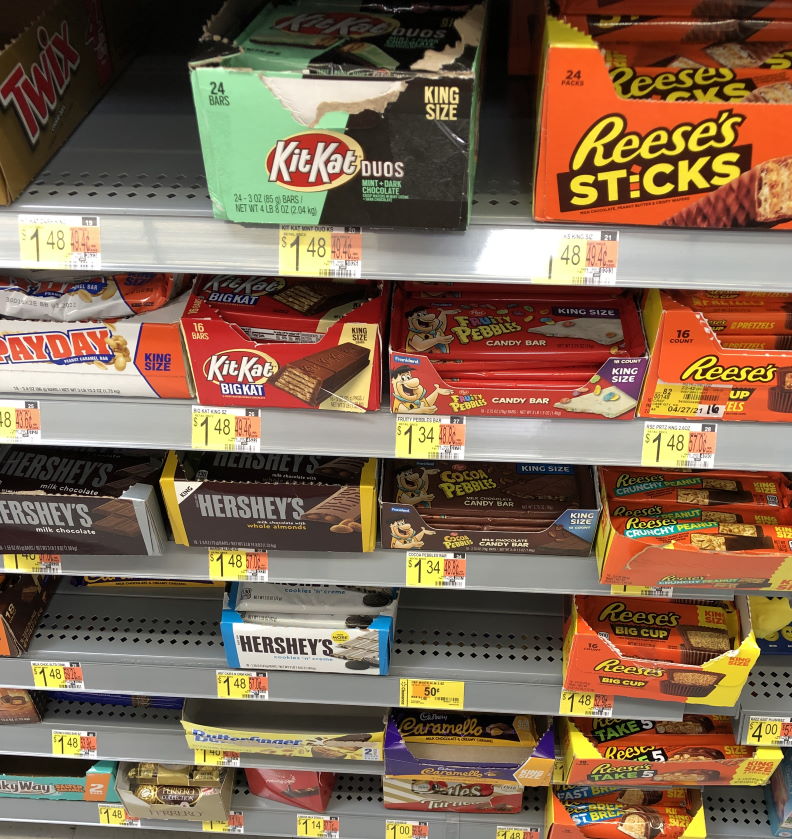
Avoid checkout candy
If you have kids you probably have already had the conversation a thousand times that they don’t need the candy by the checkout. If you are like me you just tell them no they don’t need candy and leave it at that.
But as they get older it is a good idea to explain why stores put the candy and chips and soda by the register. And why they should avoid it. It’s not just because all of that stuff is normally not good for them, but also because the convenience of this makes you spend more money.
How to be kind to others
While grocery shopping with your kids this is a perfect time to teach them something that doesn’t involve shopping. Being kind to others.
This is a great time to show kindness and love to your fellow shoppers. If you see someone struggling to reach something on the top shelf and you are tall, help them get that item. If you see a disabled person struggling to get a large item off the shelf, ask your kids to help them.
Maybe while you are going to your car you see someone that needs an extra hand loading their groceries in their car. When I was younger one of my first jobs was to be a grocery bagger/carry out boy. I would bag groceries and load them into the customer’s car. That is one job you just don’t see anymore. Having your kids help strangers bag groceries and load them in their cars is a great way to show kindness.
Using coupons and store rewards
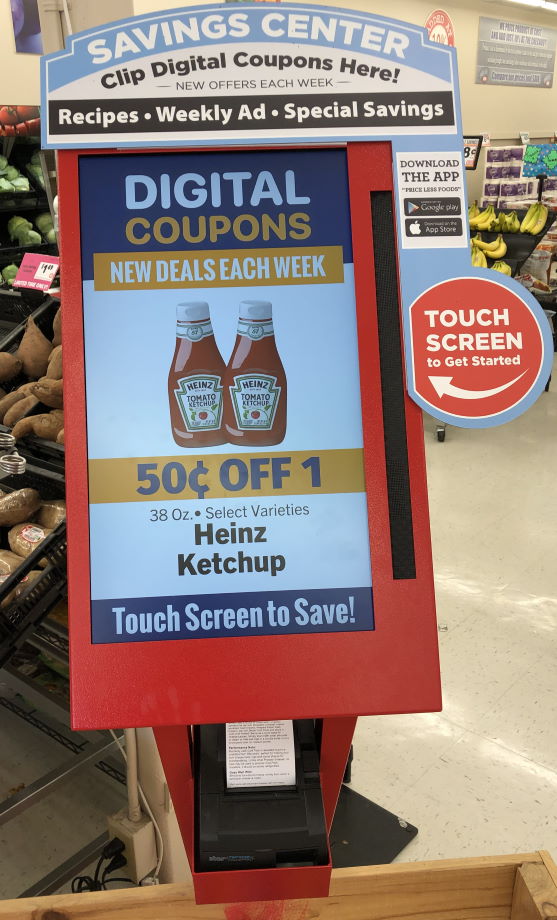
Use coupons and store rewards
There are whole websites dedicated to couponing so I won’t cover that here. But teach your kids to be frugal by utilizing coupons and store rewards programs. Here lately it is easier than ever to use them as most have gone digital.
Our local store has a kiosk up front that shows all the current digital coupons. It makes for an easy day of shopping and you can find the best deals quickly.
Also, some stores offer points to redeem for discounts or discounts on gas at their store-branded gas station. These are all great ways to teach our kids to utilize our grocery shopping to save money.
Shopping multiple stores for sales
Shopping at just one store is probably preferred by most parents. If you are towing along kids you really don’t want to get the kids out multiple times and worry about buckling and unbuckling kids all day long. But shopping multiple stores can save you a lot of money.
Just be careful when looking to shop multiple stores. Make sure you plan how much you can save by going from store to store. If you are not careful you might end up spending more money on gas than the money you would save on a sale.
Return your cart
Return your shopping cart. Teach your kids to return your shopping cart. It isn’t that hard. It doesn’t take but a few more seconds of your day. And your kids will actually have fun with it. I can remember as a kid taking the cart back was one of my favorite tasks.
Teaching our children how to shop for groceries doesn’t have to be hard or boring. If they are younger you can make shopping a big game of hide and seek. Or I spy with your grocery list. You can also teach younger kids simple addition and math by having them help count the number of items added to your cart.
As they get older you can teach them the more advanced skills. Advanced math by keeping a running total of the dollar amount of the groceries while you shop. And then even more advanced when you subtract the coupons that you want to apply. You can even have them break down the price of an item by the ounce or pound so they can calculate the price per unit.
Do you have any other grocery shopping skills that we should teach our children? If so let us know in the comments or drop us a note on our Facebook page.

These are some excellent grocery shopping tips Greg. From personal experience and as you said, NEVER GO GROCERY SHOPPING HUNGRY!!! You will end up filling up 3 shopping carts.
These are really great tips to teach kids. I always have to remember to never shop while I am hungry. I bought a lot of useless junk food when I was hungry and never again haha.
Great points. My mom always took me grocery shopping with her and it was fun to have one on one time with my mom. She taught me the price per unit. When I take my toddler with me now I also try and say things like “we need apples. Can you find the apples? How many apples should we get” and count them out loud. It has helped her learn.
This is such a fantastic list! My kids are almost old enough that I could take them with me (if I’m feeling brave) without it being a total nightmare but I never thought to teach them all these things. I love that you’ve included teaching kindness <3
Super awesome and thorough post!!
These are some very important life skills. Such a great idea to lay things out and teach them to your kids!
Gosh, this is such a great post! Thanks for being so thorough with your explanations. These are all great tips for teaching our kiddos how to grocery shop. Great life skills that are sure to set them up for success.
These are such important life skills, what a great post!
I really enjoy grocery shopping with my little ones, they too enjoy it. A great post with great tips and I completely agree, grocery shopping while hungry is such a mistake!
Very good advice!!!